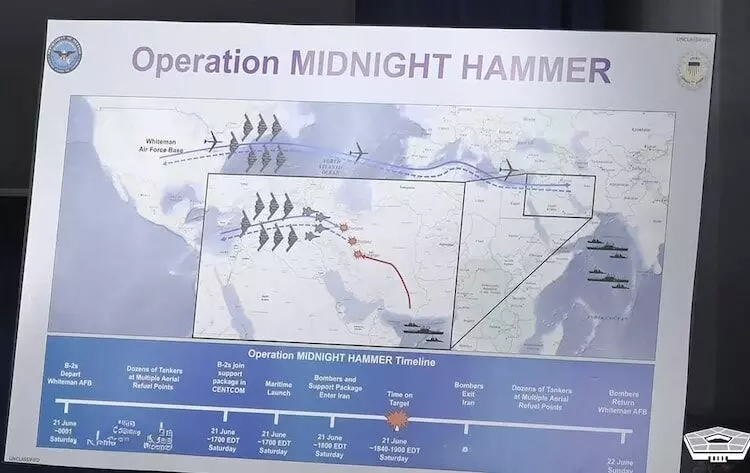Operation Midnight Hammer: US Reveals How It Hit Iran’s Nuclear Sites in Just 25 Minutes

The U.S. military’s dramatic airstrikes on three key Iranian nuclear facilities over the weekend—codenamed Operation Midnight Hammer—involved more than 125 aircraft and a coordinated deception mission, a top American general revealed on Sunday. The precision strike, completed in just 25 minutes, marked a significant escalation in the already volatile Middle East.
At a press briefing, General Dan Caine, Chairman of the Joint Chiefs of Staff, said the mission targeted Iran’s nuclear sites at Fordow, Natanz, and Isfahan. Seven B-2 Spirit stealth bombers were deployed, dropping over a dozen **30,000-pound Massive Ordnance Penetrator bombs** on the underground sites at Fordow and Natanz. Meanwhile, more than two dozen Tomahawk cruise missiles were launched from a U.S. submarine to strike the facility at Isfahan.
The bombers took off from a base in Missouri and began their attack at **6:40 p.m. ET**, exiting Iranian airspace by **7:05 p.m. ET**—making it the longest B-2 bomber mission since the 9/11 attacks, according to Caine.
“To maintain tactical surprise, part of the bomber formation was sent over the Pacific as a decoy,” said Caine, describing a deception strategy known only to a small group of top U.S. military planners and officials. “The lead B-2 bomber launched the first bunker-busters at Fordow, and the rest followed with their payloads shortly after. The Tomahawk missiles hit Isfahan just after, closing the operation.”
Caine emphasized that Iran’s air defense systems did not detect the incoming bombers or missiles. “It appears Iran’s surface-to-air systems simply didn’t see us. No U.S. military assets were targeted or hit during the mission.”
**Strategic Shift in the Middle East**
The strike comes amid rising tensions in the region, which has been engulfed in conflict for nearly two years with wars raging in Gaza, Lebanon, and Syria. The U.S. offensive followed over a week of Israeli-led assaults on Iran's missile infrastructure and air defense networks under “Operation Rising Lion.”
Iranian state media reported **at least 430 people killed and over 3,500 injured** since Israel began its attacks on June 13. In Israel, local authorities said **24 civilians have died and 1,272 have been injured** as a result of Iran's retaliatory strikes.
Speaking alongside Gen. Caine, U.S. Secretary of Defense Pete Hegseth hailed the mission as a decisive success. “Iran’s nuclear program has been devastated—obliterated,” Hegseth declared. “President Trump has always made it clear: Iran must never be allowed to possess a nuclear weapon.”
Although President Trump had previously stated he was still weighing whether to support Israel directly, he ultimately ordered the strikes just two days later, overseeing the mission from the White House Situation Room.
**Timeline of the Operation**
* **Friday midnight (ET):** B-2 bombers depart from the continental U.S.
* **Decoy strategy:** Some aircraft divert west into the Pacific to confuse enemy surveillance.
* **5:00 p.m. (ET):** U.S. submarine launches over two dozen Tomahawk missiles targeting surface infrastructure at Isfahan.
* **6:40 p.m. (ET):** Lead B-2 drops first bunker-busters on Fordow; subsequent bombers hit Natanz and other targets.
* **7:05 p.m. (ET):** All aircraft exit Iranian airspace; no response from Iranian air defenses.
**A Dangerous New Chapter**
This is the first time the U.S. has used such massive bunker-buster bombs in a strike against Iran, reflecting the seriousness with which Washington views Tehran’s nuclear program. While Iran has yet to officially respond militarily to the strikes, the scale and precision of the operation have further escalated tensions across the region.
With diplomacy all but frozen and military engagements on the rise, the region now faces the very real threat of a broader conflict—one that could draw in more nations and set back years of fragile geopolitical balance.
